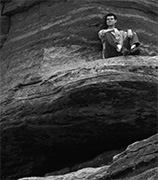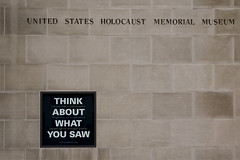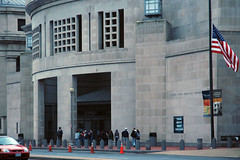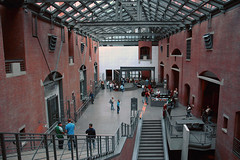Think About It
Among the myriad of monuments and museums in Washington D.C. there is the United States Holocaust Memorial Museum. Its message is begging to be understood but in a twist of irony the museum itself is a practice against civil liberties for the very same government-centralized and abusive-capitalizing concepts that were outlined in Mein Kampf itself.
Although there are pamphlets at the information desk and signs posted outside the building that emphasize the importance of spreading the knowledge, the museum refuses to empower you to do so. Copyright laws prohibit you from photographing any of the artifacts within the museum.
That's right - I said artifacts. You can't photograph the Nazi SS uniforms, the exhibit showing hundreds of victims' shoes, the reproduction artwork from the Jewish kids while they waited in the ghettos. Although these artifacts in and of themselves are not copyrighted, large poster size photographs that hang throughout the museum are. The most notable one being from Time. So because a few large posters hang in the museum, by which the story could be told well enough without, nobody is allowed to take photographs of the artifacts. Not surprisingly, you can purchase a photo book of the artifacts in the museum store.
It's insulting that our civil rights are stripped away from United States soil - not a privately operated museum, but one that our tax dollars pay for - in a museum that in itself is warning about the dangers that abound when similar liberties are forgone. You can't photograph certain touching artifacts then blog about them or show them as proof to some ignorant nazi supremist nut who claims it never happened. All because Time Life magazine says so.
Another volunteer thought that photography might be forbidden because the artifacts are light sensitive, but every artifact I could find was either rock, metal, wood, clay, cloth or a replica of paper-based items.
Furthermore, it didn't always used to be this way. Back in the summer of 2001, I remember visiting the museum and seeing many people wandering around taking flash photos. Flashes seemed to flow in a steady stream towards the replica of the "Arbeit Macht Frei" gate that once hovered over the entrance of Auschwitz-Birkenau and inside the small rail-car where as many as 100 people were coerced into a journey to their slaughter.
The clay sculpture of one of the five Auschwitz-Birkenau killing grounds was particularly moving. If you want to see it, you can come visit the museum or buy the book. There are a couple of photos on the USHMM web site (here and here), but other than that you'd be hard pressed to find any photos of it anywhere else. There are, however, some other very good exhibits that have been placed (in part) online for the public to research and learn from. Sadly, several of them appear to be geared more towards trying to sell prints than to educate the public of the atrocity that the museum claims to do.
Quite frankly, the exhibits were so poorly lit that it took twice as long to read the information cards and much of the detail in the artifacts became lost in the deep shadows. Taking a picture of anything would require a decent flash setup and a tripod.
Even photographing the outside of the building, guards came up to me and forced some to be erased. Inside the building, the people at the help desk were more generous and allowed me to take a few pictures of the hall and a few more of the children's wall. Just not the exhibits.
I jokingly suggested to someone that the guards should dress up like SS men in full Nazi uniform to emphasize both the intentional unnerving and prison like Museum, as it's designed to put you in the shoes of the desperate Jews, and their intentional unnerving prison like presence. However, the guards are neither brutal nor rude (I didn't want to oppose them out of concern that they wouldn't allow me to visit the museum). The uniforms would probably stir controversy and cause the security officers grief, so in hindsight the suggestion wasn't appropriate.
Across the street I could take pictures of the entryway to my heart's content. One of the guards mentioned that there wasn't anything they could do about that, so I'm thinking the way they reacted couldn't possibly be for security reasons. A 20x zoom easily focused in on their "top secret" conveyor belts, metal detectors and uniforms (sarcastic tone intended). Even one of the volunteers at the help desk suggested that the guards are over-reacting.
The architecture of the building is very deliberate. Beautiful on one hand, foreboding on the other.
As poor as the interior lighting was, it enhanced the surrounding metal beam and mortar factory architecture and gave a more solemn and ominous feel throughout the museum. It's an amazing experience - but an experience that's sadly constrained to those few people who are fortunate enough to visit the museum in person.
Here's where I see some of the basis of the irony:
One of Hitler's statements in Mein Kampf entailed how the bourgeoisie, the Jewish and the bought-off politicians fought for the centralization of all utilities and independent states into a singular German national power "in order to have in its hands the means and pledges for an unlimited policy of fulfillment". He emphasizes that these Jewish influenced leaders and spokesmen wanted their own sense of liberty and comfort at the cost of creating one large Marxist Socialization of the people under one centralized overbearing government to maintain their oppressive "Jewish-Democratic" Reich.
That these same concepts of centralization and oppression that Hitler pinned on the Jews and political parties appear prevalent in the United States government today under the guise of protection from terrorists; Basic civil rights are being ignored and innocent civilians acting on right written in our Constitution are being pined and are undergoing prosecution while other obvious hateful crimes are being protected under the same civil laws. Through imposing copyright restrictions and invasive searches this museum mocks itself through the very same capitalist copyrights and security that Hitler proposed the third Reich should overpower (and to a greater extent imposed through brutality).
In another portion of Mein Kampf, Hitler wrote:
The government is saying that they are protecting your interest by suppressing your civil rights.
Hitler was very much for capitalistic power and used many capitalist ideas to jab at all Jews, including patents and copyrights.
In this case our culture involves invasive and arguably ineffective searches and confiscation at airports, museums and even our homes without warrants or court orders. Horribly abusive capitalist powers use copyright laws to oppressed the public. In a true capitalist society, people would have the power to put down these organizations. America shifted focus some time back to where there are more laws, and stronger laws to protect the businesses than to protect the people.
While works should be protected and artists, inventors and creators should be rewarded, such witch hunts that the RIAA is notoriously known for and antics such as the Sony-BMG root-kit does more harm than good.
My overall desire and suggestion for the United States Holocaust Memorial Museum is to lift its photography restrictions - that all suppliers of artifacts and photographs within the museum sign a waver specific to the museum that allows for visitors to photograph freely - to truly promote the goodwill intent of the museum; Let the museum show the horrors that happen when basic human liberties are crushed in an environment that doesn't degrade the very same basic liberties that our founding fathers already fought and died for.
One of those very founding fathers, Benjamin Franklin, is credited to saying "Those who would give up ESSENTIAL LIBERTY to purchase a little TEMPORARY SAFETY, deserve neither LIBERTY nor SAFETY."
Although there are pamphlets at the information desk and signs posted outside the building that emphasize the importance of spreading the knowledge, the museum refuses to empower you to do so. Copyright laws prohibit you from photographing any of the artifacts within the museum.
That's right - I said artifacts. You can't photograph the Nazi SS uniforms, the exhibit showing hundreds of victims' shoes, the reproduction artwork from the Jewish kids while they waited in the ghettos. Although these artifacts in and of themselves are not copyrighted, large poster size photographs that hang throughout the museum are. The most notable one being from Time. So because a few large posters hang in the museum, by which the story could be told well enough without, nobody is allowed to take photographs of the artifacts. Not surprisingly, you can purchase a photo book of the artifacts in the museum store.
It's insulting that our civil rights are stripped away from United States soil - not a privately operated museum, but one that our tax dollars pay for - in a museum that in itself is warning about the dangers that abound when similar liberties are forgone. You can't photograph certain touching artifacts then blog about them or show them as proof to some ignorant nazi supremist nut who claims it never happened. All because Time Life magazine says so.
Another volunteer thought that photography might be forbidden because the artifacts are light sensitive, but every artifact I could find was either rock, metal, wood, clay, cloth or a replica of paper-based items.
Furthermore, it didn't always used to be this way. Back in the summer of 2001, I remember visiting the museum and seeing many people wandering around taking flash photos. Flashes seemed to flow in a steady stream towards the replica of the "Arbeit Macht Frei" gate that once hovered over the entrance of Auschwitz-Birkenau and inside the small rail-car where as many as 100 people were coerced into a journey to their slaughter.
The clay sculpture of one of the five Auschwitz-Birkenau killing grounds was particularly moving. If you want to see it, you can come visit the museum or buy the book. There are a couple of photos on the USHMM web site (here and here), but other than that you'd be hard pressed to find any photos of it anywhere else. There are, however, some other very good exhibits that have been placed (in part) online for the public to research and learn from. Sadly, several of them appear to be geared more towards trying to sell prints than to educate the public of the atrocity that the museum claims to do.
Quite frankly, the exhibits were so poorly lit that it took twice as long to read the information cards and much of the detail in the artifacts became lost in the deep shadows. Taking a picture of anything would require a decent flash setup and a tripod.
Even photographing the outside of the building, guards came up to me and forced some to be erased. Inside the building, the people at the help desk were more generous and allowed me to take a few pictures of the hall and a few more of the children's wall. Just not the exhibits.
I jokingly suggested to someone that the guards should dress up like SS men in full Nazi uniform to emphasize both the intentional unnerving and prison like Museum, as it's designed to put you in the shoes of the desperate Jews, and their intentional unnerving prison like presence. However, the guards are neither brutal nor rude (I didn't want to oppose them out of concern that they wouldn't allow me to visit the museum). The uniforms would probably stir controversy and cause the security officers grief, so in hindsight the suggestion wasn't appropriate.
Across the street I could take pictures of the entryway to my heart's content. One of the guards mentioned that there wasn't anything they could do about that, so I'm thinking the way they reacted couldn't possibly be for security reasons. A 20x zoom easily focused in on their "top secret" conveyor belts, metal detectors and uniforms (sarcastic tone intended). Even one of the volunteers at the help desk suggested that the guards are over-reacting.
The architecture of the building is very deliberate. Beautiful on one hand, foreboding on the other.
As poor as the interior lighting was, it enhanced the surrounding metal beam and mortar factory architecture and gave a more solemn and ominous feel throughout the museum. It's an amazing experience - but an experience that's sadly constrained to those few people who are fortunate enough to visit the museum in person.
Here's where I see some of the basis of the irony:
One of Hitler's statements in Mein Kampf entailed how the bourgeoisie, the Jewish and the bought-off politicians fought for the centralization of all utilities and independent states into a singular German national power "in order to have in its hands the means and pledges for an unlimited policy of fulfillment". He emphasizes that these Jewish influenced leaders and spokesmen wanted their own sense of liberty and comfort at the cost of creating one large Marxist Socialization of the people under one centralized overbearing government to maintain their oppressive "Jewish-Democratic" Reich.
That these same concepts of centralization and oppression that Hitler pinned on the Jews and political parties appear prevalent in the United States government today under the guise of protection from terrorists; Basic civil rights are being ignored and innocent civilians acting on right written in our Constitution are being pined and are undergoing prosecution while other obvious hateful crimes are being protected under the same civil laws. Through imposing copyright restrictions and invasive searches this museum mocks itself through the very same capitalist copyrights and security that Hitler proposed the third Reich should overpower (and to a greater extent imposed through brutality).
In another portion of Mein Kampf, Hitler wrote:
The responsibility for this situation is to be attributed solely to those parties who preach unceasingly to the patient electoral masses on the necessity of maintaining the autonomy of the federal states, while at the same time they champion and demand of the Reich a policy which must necessarily lead to the suppression of even the very last of those so-called 'sovereign' rights.Translation:
The government is saying that they are protecting your interest by suppressing your civil rights.
Hitler was very much for capitalistic power and used many capitalist ideas to jab at all Jews, including patents and copyrights.
V I C XI: [The Jew] begs for 'patents' and 'privileges,' which the lords, always in financial straits, are glad to give him for suitable payment. [...] A true blood-sucker that attaches himself to the body of the unhappy people and cannot be picked off.Hitler also emphasized the importance and effectiveness of culture over politics. Once something becomes ingrained as part of a nation's culture it's accepted among the public, While something of political standpoint is more often refuted.
V II C X: It is certain that in the future the importance of the individual [states] will be transferred to the sphere of our cultural policy.
In this case our culture involves invasive and arguably ineffective searches and confiscation at airports, museums and even our homes without warrants or court orders. Horribly abusive capitalist powers use copyright laws to oppressed the public. In a true capitalist society, people would have the power to put down these organizations. America shifted focus some time back to where there are more laws, and stronger laws to protect the businesses than to protect the people.
While works should be protected and artists, inventors and creators should be rewarded, such witch hunts that the RIAA is notoriously known for and antics such as the Sony-BMG root-kit does more harm than good.
My overall desire and suggestion for the United States Holocaust Memorial Museum is to lift its photography restrictions - that all suppliers of artifacts and photographs within the museum sign a waver specific to the museum that allows for visitors to photograph freely - to truly promote the goodwill intent of the museum; Let the museum show the horrors that happen when basic human liberties are crushed in an environment that doesn't degrade the very same basic liberties that our founding fathers already fought and died for.
One of those very founding fathers, Benjamin Franklin, is credited to saying "Those who would give up ESSENTIAL LIBERTY to purchase a little TEMPORARY SAFETY, deserve neither LIBERTY nor SAFETY."
Labels: civil liberties, copyright, forbidden, freedom, holocaust, liberty, museum, photography, security, think, ushmm












0 Comments:
Post a Comment<< Home